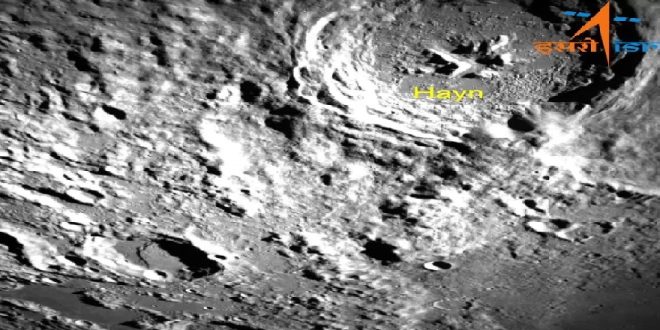22-08-2023
Bureau Report + Agencies
NEW DELHI: India’s space agency has released images of the far side of the Moon as its third lunar mission attempts to locate a safe landing spot on the little-explored South Pole.
 The pictures have been taken by Vikram, Chandrayaan-3’s lander, which began the last phase of its mission on Thursday.
The pictures have been taken by Vikram, Chandrayaan-3’s lander, which began the last phase of its mission on Thursday.
Vikram, which carries a rover in its belly, is due to land on 23 August.
The photos come a day after Russia’s Luna-25 spacecraft crashed into the Moon after spinning out of control.
The craft Russia’s first Moon mission in nearly 50 years was due to be the first ever to land on the South Pole, but failed after encountering problems as it moved into its pre-landing orbit.
On Monday morning, the Indian Space Research Organization (ISRO) said the lander from Chandrayaan-3, which is due to touch down on Wednesday at 18:04 India time (12:34 GMT), has been mapping the landing area and taking images with its “hazard detection and avoidance” camera.
ISRO added that the black-and-white images sent by this camera will assist them “in locating a safe landing area – without boulders or deep trenches”.
 The lunar far side is the side that faces away from the Earth and is sometimes also called “the dark side of the Moon” because so little is known about it. Scientists say landing there can be a tricky affair.
The lunar far side is the side that faces away from the Earth and is sometimes also called “the dark side of the Moon” because so little is known about it. Scientists say landing there can be a tricky affair.
ISRO said on Sunday that the lander module had been successfully lowered into an orbit closer to the Moon (of 25km by 134km) and is now waiting for the lunar Sun-rise to land.
If Chandrayaan-3 is successful, India will be first to land on the lunar South Pole. It will also be only the fourth country to achieve a soft landing on the Moon after the US, the former Soviet Union and China.
The third in India’s program of lunar exploration, Chandrayaan-3 is expected to build on the success of its earlier Moon missions.
It comes 15 years after the country’s first Moon mission in 2008, which discovered the presence of water molecules on the parched lunar surface and established that the Moon has an atmosphere during daytime.
Chandrayaan-2 which also comprised an orbiter, a lander and a rover – was launched in July 2019 but it was only partially successful. Its orbiter continues to circle and study the Moon even today, but the lander-rover failed to make a soft landing and crashed during touchdown.
 Pressmediaofindia
Pressmediaofindia




